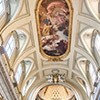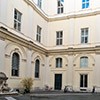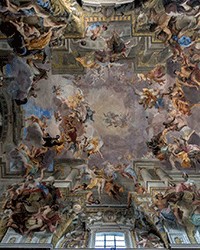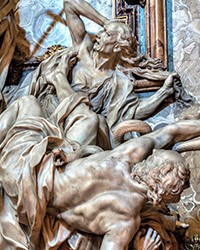
Church of Sant'Apollinare, the culmination of the main altar, angels - Bernardino Ludovisi

Church of Sant'Apollinare, interior

Church of Sant'Apollinare, interior

Church of Sant'Apollinare, main altar

Church of Sant'Apollinare, the culmination of the main altar, angels - Bernardino Ludovisi

Church of Sant'Apollinare, one of the angels from the high altar, Bernardino Ludovisi

Church of Sant'Apollinare, vault, fresco - Gloria of St. Apollinaris
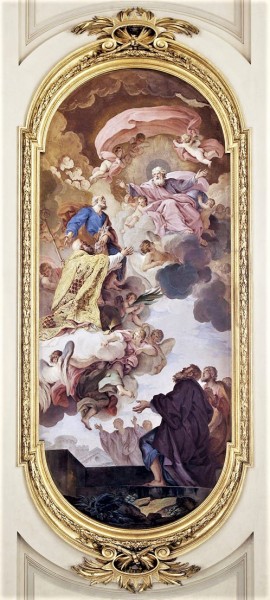
Church of Sant'Apollinare, fresco - Gloria of St. Apollinaris, Stefano Pozzi

Church of Sant'Apollinare, the chapel of Francis Xavier, the statue of St. Francis Xavier, Pierre Le Gros

Church of Sant'Apollinare, statue of Francis Xavier, Pierre Le Gros

Church of Sant'Apollinare, statue of Ignatius Loyola, Carlo Marchionni

Church of Sant'Apollinare, statue of Ignatius Loyola, Carlo Marchionni

Church of Sant'Apollinare, passage between the chapels

Church of Sant'Apollinare, side chapel - fresco from the 15th century depicting the Virgin and Child and Saints Peter and Paul

Church of Sant'Apollinare, side chapel - 15th-century fresco depicting the Virgin and Child and Saints Peter and Paul

Church of Sant'Apollinare, facade

Church of Sant'Apollinare, next to the building designed by Ferdinand Fuga, currently the seat of the Pontifical University of the Holy Cross

The courtyard of the building of the Pontifical University of the Holy Cross

The courtyard of the building of the Pontifical University of the Holy Cross

Church of Sant'Apollinare and the building of the Collegium Germanicum, engraving from the 18th century, Giuseppe Vasi
This little-known and not particularly distinguishable church had only become famous fairly recently. The crowds shouting and protesting in front of its façade had attracted attention to it, due to an issue that was rather shameful for the church, we may even say disgraceful. There was renewed discussion about the ever-present friendship between the Tiara and the criminal world, as well as the shady businesses and shady dealings of the people of the Church. Presently the church is a basilica minor a title which it acquired in 1984 thanks to Pope John Paul II. It was also during his pontificate that a mysterious event took place there.
This little-known and not particularly distinguishable church had only become famous fairly recently. The crowds shouting and protesting in front of its façade had attracted attention to it, due to an issue that was rather shameful for the church, we may even say disgraceful. There was renewed discussion about the ever-present friendship between the Tiara and the criminal world, as well as the shady businesses and shady dealings of the people of the Church. Presently the church is a basilica minor a title which it acquired in 1984 thanks to Pope John Paul II. It was also during his pontificate that a mysterious event took place there.
It all started when, in February of 1990, near Campo de’Fiori two killers shot Enrico de Pedis – a well-known Roman gangster and a boss of a gang known as Magliana. He was buried at the del Verano Cemetery, but several days later his body was mysteriously moved to a crypt in the Church of Sant'Apollinare and laid to rest in a monumental, worthy of a head of state, sarcophagus next to Cardinal Domenico Ioro and a musician from the Baroque period Giacomo Carissimi. This fact – discovered by the media by accident in 1997 – aroused discussion as well as general disapproval in Italy. The dignified place of burial of a Mafioso was explained by the then authorities in the Vatican, who cared for the basilica, as thanks for his generosity and philanthropy, as well as the friendship that developed between the criminal (when he was still alive) and the then rector of the basilica, Pietro Vergari. As opposed to what sources at the Vatican proclaimed, the media speculated that this was a form of repayment for the role the criminal had played in the talks between the mafia and the Vatican, with the aim of appeasing the Sicilian Cosa Nostra and convincing them to stop using blackmail which it had been doing due to the financial losses incurred in the Milan-based Ambrosiano Bank, connected with the Vatican. The issue died down until 2012 when the gangster was connected with the mysterious disappearance (in 1983) of Emanuela Orlandi – the fifteen-year-old daughter of a Vatican official, and a citizen of the Vatican, of whom all traces have vanished. After an anonymous phone call to a TV program devoted to lost persons, the police decided to enter an inaccessible crypt of the church and open the criminal's tomb expecting to find the teenager's remains. They were not found, however, the Vatican authorities at that time decided to remove the ashes of de Pedis from the crypt.

And thus the world found out about a small church in the center of the city, which today is in the care of Opus Dei. The rich and long history of this structure dates back to the VIII century. It was then (approx. year 780), on the remains of the Baths of Nero, a small church was erected, whose funder was – according to the Liber Pontificalis – Pope Hadrian I. He was also to have funded the monastery belonging to the church, which was designated for the Basilian monks fleeing Constantinople. The small three-nave church preceded by a small portico and finished off with a large apse, was dedicated to St. Apollinaris, who according to tradition came to the Eternal City from Antioch along with St. Peter. He was ordained (as legend would have it) as bishop and sent to Ravenna, where he died a martyr's death under unknown circumstances. In Ravenna, we can find two early-Christian churches dedicated to him (Sant'Apollinare in Classe and Sant' Apollinare Nuovo), magnificently decorated with multicolored mosaics.
For nearly one thousand years, the Roman Church of Sant’Apollinare continued in its original form, until 1742 when due to the upcoming Jubilee Year (1750) Pope Benedict XIV, decided to thoroughly modernize in the late Baroque and Classicist style, entrusting this task to his trusted architect Ferdinando Fuga. He created a single-nave interior, with chapels opening up onto it, finished with a dome where the nave and the presbytery come together.
In the glittering, rich in multi-colored marble surfaces we will not find too many outstanding works of art, although a few may arouse our interest. Looking up, we will see the fresco The Glory of St. Apollinaris by the talented fresco maker of those times – Stefano Pozzi. In the side chapels the following saints are venerated: Aloysius of Gonzaga, Joseph and Francis Xavier (on the right side), as well as John of Nepomuk, Josemaria Escrivà de Balaguer (the founder of Opus Dei), and Ignatius of Loyola (on the left side). The altars dedicated to the three Jesuit saints should not surprise us, as during the years of 1574-1773, the church belonged to the Society of Jesus, while in the neighboring building (the former Basilian monastery), renovated and enlarged an important educational center of the Jesuit missions was located, known as Collegium Germanicum and Hungaricum.

As far as artistic value goes, undoubtedly the most interesting is the chapel dedicated to Francis Xavier, in which we can find the work of the sculptor working for the Jesuits – Pierre Le Gros. The statue of the saint missionary in excellently portrayed, flowing in cascades surplice, holding a crucifix in his hands is enriched by a metal crab found at its feet. According to a legend, the crustacean was to fish the crucifix out of the sea, when during a storm it slipped out of the Jesuit’s hands. It was with this cross that Francis Xavier calmed the raging waves during his journey to the Far East. A second sculpture that will probably attract our attention is the statue of Ignatius of Loyola, the work of a late-Baroque sculptor and architect Carlo Marchionni. The main altar of the church is decorated by the reredos representing St. Peter ordaining Apollinaris. It is a copy of a painting completed by Ercole Graziani for the cathedral in Bologna, but the thing that attracts our attention is the angels and putti made out of marble and stucco, which finish off the painting - the work of Bernardo Ludovisi, well-known for his amazing creations of angels in the Church of Sant’Ignazio.
Entering the church, or leaving it, we can also notice a small chapel, which is part of it, but seems to stand on its own, located parallel to the façade of the building. It was here that in bygone times, the aforementioned portico of the early-Roman church was located. Later bricked up, it presently constitutes the background for the exceptional work of art – framed by the XV-century fresco with the image of Our Lady with Child and SS Peter and Paul.
Today, the building of the Pontifical University of the Holy Cross, built by Ferdinando Fuga in the middle of the XVIII century stands next to the church. It is worth going to the newly renovated courtyard of this building, which is adorned by a beautiful fountain.



























